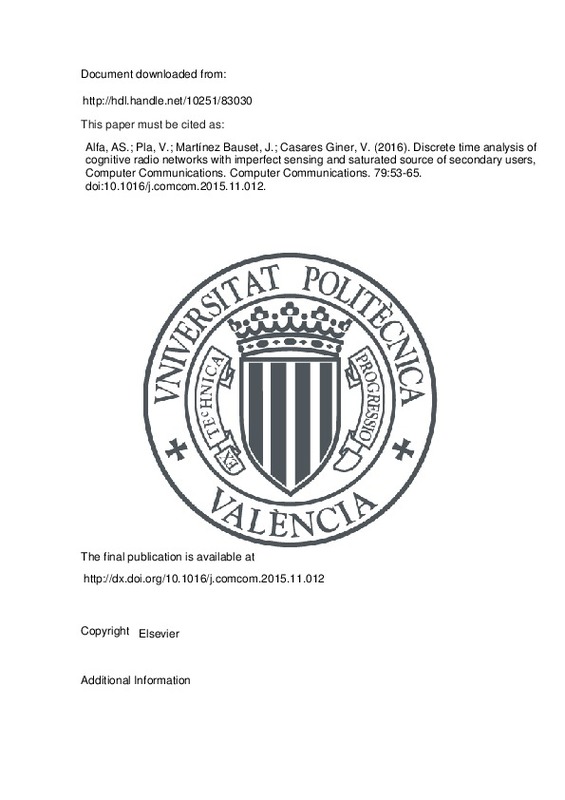JavaScript is disabled for your browser. Some features of this site may not work without it.
Buscar en RiuNet
Listar
Mi cuenta
Estadísticas
Ayuda RiuNet
Admin. UPV
Discrete time analysis of cognitive radio networks with imperfect sensing and saturated source of secondary users, Computer Communications
Mostrar el registro sencillo del ítem
Ficheros en el ítem
| dc.contributor.author | Alfa, A. S.
|
es_ES |
| dc.contributor.author | Pla, Vicent
|
es_ES |
| dc.contributor.author | Martínez Bauset, Jorge
|
es_ES |
| dc.contributor.author | Casares Giner, Vicente
|
es_ES |
| dc.date.accessioned | 2017-06-16T09:52:39Z | |
| dc.date.available | 2017-06-16T09:52:39Z | |
| dc.date.issued | 2016-04-01 | |
| dc.identifier.issn | 0140-3664 | |
| dc.identifier.uri | http://hdl.handle.net/10251/83030 | |
| dc.description.abstract | Sensing is one of the most challenging issues in cognitive radio networks. Selection of sensing parameters raises several tradeoffs between spectral efficiency, energy efficiency and interference caused to primary users (PUs). In this paper we provide representative mathematical models that can be used to analyze sensing strategies under a wide range of conditions. The activity of PUs in a licensed channel is modeled as a sequence of busy and idle periods, which is represented as an alternating Markov phase renewal process. The representation of the secondary users (SUs) behavior is also largely general: the duration of transmissions, sensing periods and the intervals between consecutive sensing periods are modeled by phase type distributions, which constitute a very versatile class of distributions. Expressions for several key performance measures in cognitive radio networks are obtained from the analysis of the model. Most notably, we derive the distribution of the length of an effective white space; the distributions of the waiting times until the SU transmits a given amount of data, through several transmission epochs uninterruptedly; and the goodput when an interrupted SU transmission has to be restarted from the beginning due to the presence of a PU. (C) 2015 Elsevier B.V. All rights reserved. | es_ES |
| dc.description.sponsorship | The research of A. S. Alfa was partially supported by the NSERC (Natural Sciences and Engineering Research Council) of Canada under Grant G00315156. Most of the contribution of V. Pla was done while visiting the University of Manitoba. This visit was supported by the Ministerio de Educacion of Spain under Grant PR2011-0055, and by the UPV through the Programa de Apoyo a la Investigacion y Desarrollo (PAID-00-12). The research of the authors from the Universitat Politecnica de Valencia was partially supported by the Ministry of Economy and Competitiveness of Spain under Grant TIN2013-47272-C2-1-R. | en_EN |
| dc.language | Inglés | es_ES |
| dc.publisher | Elsevier | es_ES |
| dc.relation.ispartof | Computer Communications | es_ES |
| dc.rights | Reserva de todos los derechos | es_ES |
| dc.subject | Cognitive radio | es_ES |
| dc.subject | Sensing | es_ES |
| dc.subject | Performance modeling | es_ES |
| dc.subject | Discrete time Markov model | es_ES |
| dc.subject | Phase type distribution | es_ES |
| dc.subject.classification | INGENIERIA TELEMATICA | es_ES |
| dc.title | Discrete time analysis of cognitive radio networks with imperfect sensing and saturated source of secondary users, Computer Communications | es_ES |
| dc.type | Artículo | es_ES |
| dc.identifier.doi | 10.1016/j.comcom.2015.11.012 | |
| dc.relation.projectID | info:eu-repo/grantAgreement/NSERC//G00315156/ | es_ES |
| dc.relation.projectID | info:eu-repo/grantAgreement/ME//PR2011-0055/ES/PR2011-0055/ | es_ES |
| dc.relation.projectID | info:eu-repo/grantAgreement/UPV//PAID-00-12/ | es_ES |
| dc.relation.projectID | info:eu-repo/grantAgreement/MINECO//TIN2013-47272-C2-1-R/ES/PLATAFORMA DE SERVICIOS PARA CIUDADES INTELIGENTES CON REDES M2M DENSAS/ | es_ES |
| dc.rights.accessRights | Abierto | es_ES |
| dc.contributor.affiliation | Universitat Politècnica de València. Escuela Técnica Superior de Ingenieros de Telecomunicación - Escola Tècnica Superior d'Enginyers de Telecomunicació | es_ES |
| dc.description.bibliographicCitation | Alfa, AS.; Pla, V.; Martínez Bauset, J.; Casares Giner, V. (2016). Discrete time analysis of cognitive radio networks with imperfect sensing and saturated source of secondary users, Computer Communications. Computer Communications. 79:53-65. https://doi.org/10.1016/j.comcom.2015.11.012 | es_ES |
| dc.description.accrualMethod | S | es_ES |
| dc.relation.publisherversion | http://dx.doi.org/10.1016/j.comcom.2015.11.012 | es_ES |
| dc.description.upvformatpinicio | 53 | es_ES |
| dc.description.upvformatpfin | 65 | es_ES |
| dc.type.version | info:eu-repo/semantics/publishedVersion | es_ES |
| dc.description.volume | 79 | es_ES |
| dc.relation.senia | 297790 | es_ES |
| dc.contributor.funder | Ministerio de Educación | es_ES |
| dc.contributor.funder | Natural Sciences and Engineering Research Council of Canada | es_ES |
| dc.contributor.funder | Ministerio de Economía y Competitividad | es_ES |
| dc.contributor.funder | Universitat Politècnica de València | es_ES |







![[Cerrado]](/themes/UPV/images/candado.png)

